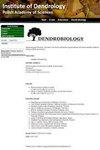温度和外源生长素对刺柏扦插繁殖的影响
IF 1.8
4区 农林科学
Q2 FORESTRY
引用次数: 2
摘要
从过去到现在,杜松的文化、药用、景观和烹饪用途使其成为世界上分布最广泛的木本植物之一。因此,找到合适的生产方法以获得符合使用面积的优质苗木是非常重要的。本研究以刺柏、刺柏和刺柏为试材,确定了刺柏扦插繁殖的最佳条件和应用。为此目的,两种不同的温室处理(温室-1,空气温度为20±2°C,生根台温度为25±2℃,湿度水平为70±2%;温室-2,空气温度20±2℃、生根台温度20±2%,湿度水平70±2%)和不同的生长素应用(浓度为3000和5000ppm的吲哚-3-丁酸、吲哚-3-乙酸和α-萘乙酸)。通常在Greenhouse-1中获得最高的生根率。用IAA 5000ppm处理的‘Hibernica’和‘Stricta’(66.67%,也在温室-2中)和用IBA 3000ppm处理的〈Stricta Variegata’(60.00%)生根效果最好。本研究调查了一些杜松属植物的最佳生产条件,为生产者确保杜松的可持续利用提供了指导。本文章由计算机程序翻译,如有差异,请以英文原文为准。
The effects of temperature and exogenous auxin on cutting propagation of some junipers
From past to the present, cultural, medicinal, landscape and culinary use of junipers has contributed to it being one of the most widely distributed woody plants in the world. Therefore, it is so important that finding appropriate production methods to obtain quality seedlings in line with the usage area. In the present study, it was tried to determine the best conditions and applications on propagation by cuttings of three juniper taxa including Juniperus communis L. ‘Hibernica’, Juniperus chinensis L. ‘Stricta’, and Juniperus chinensis L. ‘Stricta Variegata’. For this purpose, two different greenhouse treatments (Greenhouse-1 with the air temperature at 20±2°C, rooting table temperature at 25±2°C and humidity level at 70±2%; Greenhouse-2 with the air temperature at 20±2°C, rooting table temperature at 20±2°C and humidity level at 70±2%) and different auxin applications (Indole-3-Butyric Acid, Indole-3-Acetic Acid and α-Naphthalene Acetic Acid at concentrations of 3000 and 5000 ppm) were designed. The highest rooting percentages were generally achieved in Greenhouse-1. IAA 5000 ppm treatment for J. communis ‘Hibernica’ (93.33%) and J. chinensis ‘Stricta’ (66.67%, also in Greenhouse-2) and IBA 3000 ppm treatment for J. chinensis ‘Stricta Variegata’ (60.00%) showed the best rooting results. This study, in which the best production conditions are investigated in some juniper taxa, is a guiding feature for the producers to ensure the sustainable utilization of junipers.
求助全文
通过发布文献求助,成功后即可免费获取论文全文。
去求助
来源期刊

Dendrobiology
农林科学-林学
CiteScore
2.20
自引率
11.10%
发文量
17
审稿时长
>12 weeks
期刊介绍:
Dendrobiology publishes original research articles and review articles related to the biology of trees and shrubs.
 求助内容:
求助内容: 应助结果提醒方式:
应助结果提醒方式:


